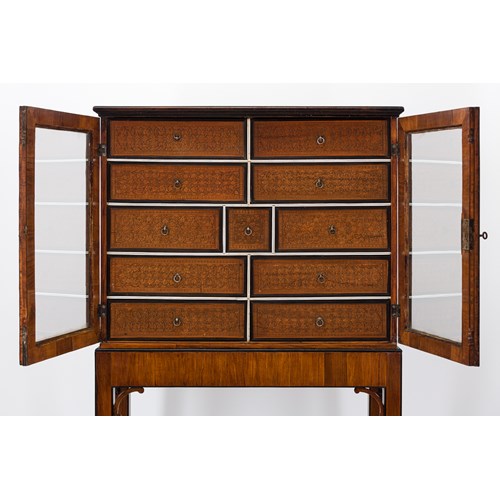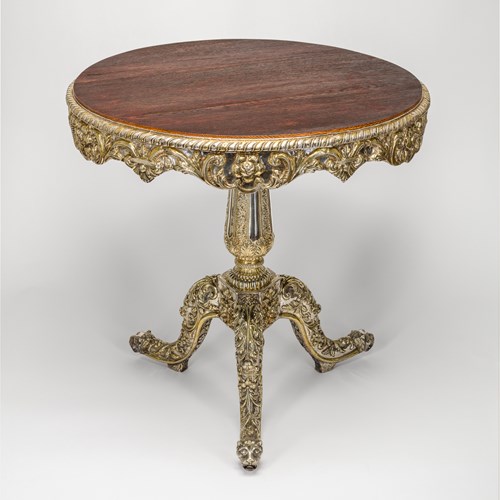Marketplace
Cloisonné and Gilt-Bronze Bottle (ṣurāḥī)
Cloisonné and Gilt-Bronze Bottle (ṣurāḥī)
Period Qianlong reign period (1736–95)
Origin China
Medium Cloisonné enamels with gilding on a copper base
Dimension 28.5 cm (11¹/₄ inches)
Made for the Islamic Market
Stock No.: A5138
The basic shape of the bottle with pear- shaped body and long neck follows a Chinese prototype that is seen frequently in Chinese decorative arts, including cloisonné enamel.1 The shape was already common by the second century BC (the Han dynasty, 206 BC-220 AD).2 In this piece, however, the form has been modified to that of a ṣurāḥī, a vessel for water known across the Islamic world. The original ṣurāḥī were made in metal, and were distinguished by the bulbous rib halfway down the neck. The shape was also often made in ceramic, and was common in the 16th and 17th century.3 It was a form unknown in China, thus demonstrating that this rare cloisonné vessel was made for export to Southeast Asia, India or the Middle East. It is a luxury product of high quality made in an expensive medium, that of enamels on copper. Cloisonné enamel vessels in China were only made for temples and palaces, not for ordinary use. Thus the bottle must have been a “special order” rather than an ordinary export piece.
The pattern on the bottle is of scrolling baoxiang flowers, a common design in Chinese decorative arts. Baoxiang are composite flowers that symbolise good fortune and combine elements of peony, lotus and chrysanthemum. It was a recurrent motif on gold and silver utensils, embroidery and architecture in ancient China, and from there lent itself to ceramic and cloisonné decoration also. The regularity of the baoxiang pattern, the shapes of the flower heads and the stubby leaves, and the colour of the enamels, are comparable with other vessels made during the Qianlong reign, for example an altar vessel with Qianlong reign mark in the Khalili Collection and a pair of long-necked vases in the Pierre Uldry Collection in the Museum Rietberg in Zürich.4 Rising from the bottom of the body is a circle of upraised lotus petals, symbolising purity and attainment, and above the foot a squared, geometric design derived from ancient bronzes. Thus all the decorations on the bottle are auspicious in Chinese terms, while also being non-figurative to satisfy Islamic clients.
Footnotes:
1. For example, a pair of long-necked vases in Béatrice Quette (ed.), Cloisonné. Chinese Enamels from the Yuan, Ming, and Qing Dynasties, Bard Graduate Center, New York; Les Arts Décoratifs – musée des Art Décoratifs, Paris; Yale University Press, New Haven and London, 2011, no.6, p.226.
2. A bronze example dating to the 2nd century BC is in James C.S. Lin, The Search for Immortality. Tomb Treasures of Han China, Cambridge University Press, 2012, no.187, p.313.
3. See the following ceramic ṣurāḥī at the Victoria and Albert Museum; Accession Numbers and Dates: 70–1866, ca. 1535–40; C.2012–1910, dated to ca. 1545; 6784–1860, second half of 16th century;
C. 2002–1910, dated to ca. 1585; 2497–1876, dated to 1630–60; 2495–1876, dated to 1650–1700.
4. Rose Kerr, “Enamel in China” in Enamels of the World 1700–2000. The Khalili Collections, Haydn Williams (ed.) The Khalili Family Trust, 2009, no.67, pp.122-123.
Helmut Brinker and Albert Lutz, Chinesisches Cloisonné. Die Sammlung Pierre Uldry (Museum Rietberg, Zürich, 1985), no.251, p.252.
Stock No.: A5138
The basic shape of the bottle with pear- shaped body and long neck follows a Chinese prototype that is seen frequently in Chinese decorative arts, including cloisonné enamel.1 The shape was already common by the second century BC (the Han dynasty, 206 BC-220 AD).2 In this piece, however, the form has been modified to that of a ṣurāḥī, a vessel for water known across the Islamic world. The original ṣurāḥī were made in metal, and were distinguished by the bulbous rib halfway down the neck. The shape was also often made in ceramic, and was common in the 16th and 17th century.3 It was a form unknown in China, thus demonstrating that this rare cloisonné vessel was made for export to Southeast Asia, India or the Middle East. It is a luxury product of high quality made in an expensive medium, that of enamels on copper. Cloisonné enamel vessels in China were only made for temples and palaces, not for ordinary use. Thus the bottle must have been a “special order” rather than an ordinary export piece.
The pattern on the bottle is of scrolling baoxiang flowers, a common design in Chinese decorative arts. Baoxiang are composite flowers that symbolise good fortune and combine elements of peony, lotus and chrysanthemum. It was a recurrent motif on gold and silver utensils, embroidery and architecture in ancient China, and from there lent itself to ceramic and cloisonné decoration also. The regularity of the baoxiang pattern, the shapes of the flower heads and the stubby leaves, and the colour of the enamels, are comparable with other vessels made during the Qianlong reign, for example an altar vessel with Qianlong reign mark in the Khalili Collection and a pair of long-necked vases in the Pierre Uldry Collection in the Museum Rietberg in Zürich.4 Rising from the bottom of the body is a circle of upraised lotus petals, symbolising purity and attainment, and above the foot a squared, geometric design derived from ancient bronzes. Thus all the decorations on the bottle are auspicious in Chinese terms, while also being non-figurative to satisfy Islamic clients.
Footnotes:
1. For example, a pair of long-necked vases in Béatrice Quette (ed.), Cloisonné. Chinese Enamels from the Yuan, Ming, and Qing Dynasties, Bard Graduate Center, New York; Les Arts Décoratifs – musée des Art Décoratifs, Paris; Yale University Press, New Haven and London, 2011, no.6, p.226.
2. A bronze example dating to the 2nd century BC is in James C.S. Lin, The Search for Immortality. Tomb Treasures of Han China, Cambridge University Press, 2012, no.187, p.313.
3. See the following ceramic ṣurāḥī at the Victoria and Albert Museum; Accession Numbers and Dates: 70–1866, ca. 1535–40; C.2012–1910, dated to ca. 1545; 6784–1860, second half of 16th century;
C. 2002–1910, dated to ca. 1585; 2497–1876, dated to 1630–60; 2495–1876, dated to 1650–1700.
4. Rose Kerr, “Enamel in China” in Enamels of the World 1700–2000. The Khalili Collections, Haydn Williams (ed.) The Khalili Family Trust, 2009, no.67, pp.122-123.
Helmut Brinker and Albert Lutz, Chinesisches Cloisonné. Die Sammlung Pierre Uldry (Museum Rietberg, Zürich, 1985), no.251, p.252.
Period: Qianlong reign period (1736–95)
Origin: China
Medium: Cloisonné enamels with gilding on a copper base
Dimension: 28.5 cm (11¹/₄ inches)
More artworks from the Gallery


_T638563980981131436.jpg?width=2000&height=2000&mode=max&scale=both&qlt=90)



 Silver Web_T638206163549784171.JPG?width=500&height=500&mode=pad&scale=both&qlt=90&format=jpg)


 with Mother-of-Pearl Handle_T638839371438778571.jpg?width=500&height=500&mode=pad&scale=both&qlt=90&format=jpg)